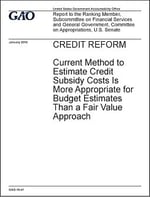 This week, the Government Accountability Office (GAO) posted a new credit reform report entitled "Current Method to Estimate Credit Subsidy Costs Is More Appropriate for Budget Estimates Than a Fair Value Approach." Read on for a quick summary.
This week, the Government Accountability Office (GAO) posted a new credit reform report entitled "Current Method to Estimate Credit Subsidy Costs Is More Appropriate for Budget Estimates Than a Fair Value Approach." Read on for a quick summary.
Summary of GAO's Assessment of Fair Value
For those who don't have time to read the entire report, here are four major takeaways:
- GAO found that the current system, provided for by the Federal Credit Reform Act of 1990 (FCRA), has not consistently underestimated or overestimated the cost of credit policy, even through the Great Recession. In other words, FCRA worked pretty well even during one of the most volatile periods of American financial history.
- Further, GAO explained that FCRA’ suggested replacement, fair value, would require the measurement of non-cash costs like opportunity costs or social cost. According to GAO, including these costs in a budget is not consistent with long-standing federal budgeting practices that focus on cash outlays.
- GAO also pointed out that requiring all agencies to implement fair value for budgeting would involve significant implementation and consistency challenges across agencies.
- Finally, GAO observed that, at loan termination, the FCRA and fair value would end up at the same cost anyway. This suggests that interim differences implied by fair value may be misleading to those who fund, make, and follow budgets.
More on Fair Value
 For more background, see my white paper and blog entries on fair value:
For more background, see my white paper and blog entries on fair value:


 This week, the Government Accountability Office (GAO) posted a new credit reform report entitled "Current Method to Estimate Credit Subsidy Costs Is More Appropriate for Budget Estimates Than a Fair Value Approach." Read on for a quick summary.
This week, the Government Accountability Office (GAO) posted a new credit reform report entitled "Current Method to Estimate Credit Subsidy Costs Is More Appropriate for Budget Estimates Than a Fair Value Approach." Read on for a quick summary. For more background, see my white paper and blog entries on fair value:
For more background, see my white paper and blog entries on fair value: